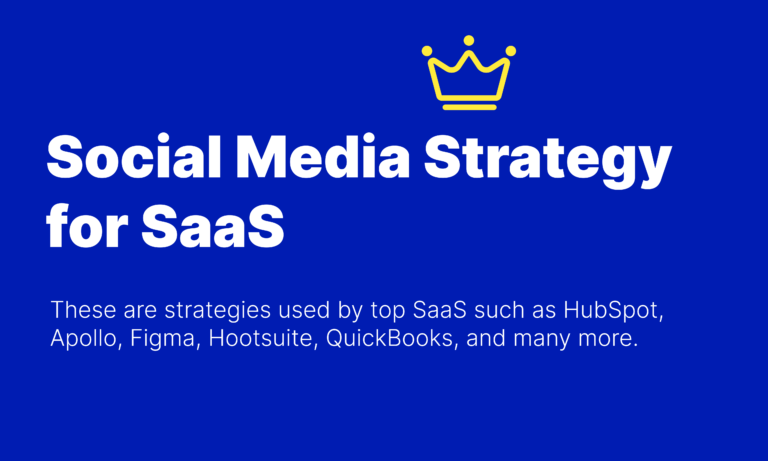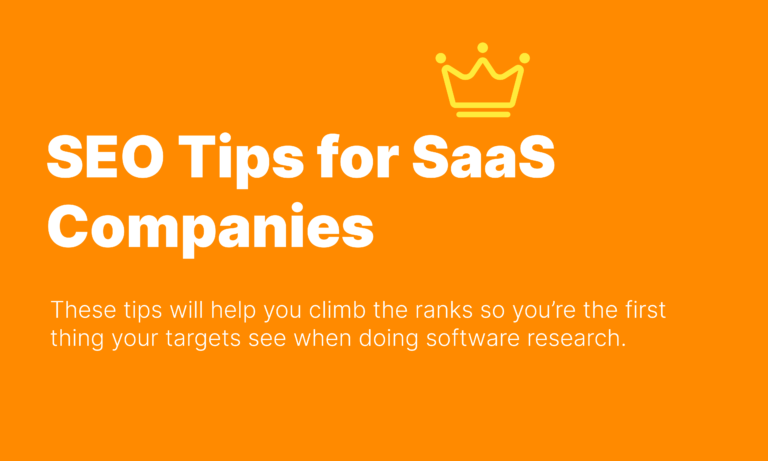Best Content Marketing Strategies for SaaS
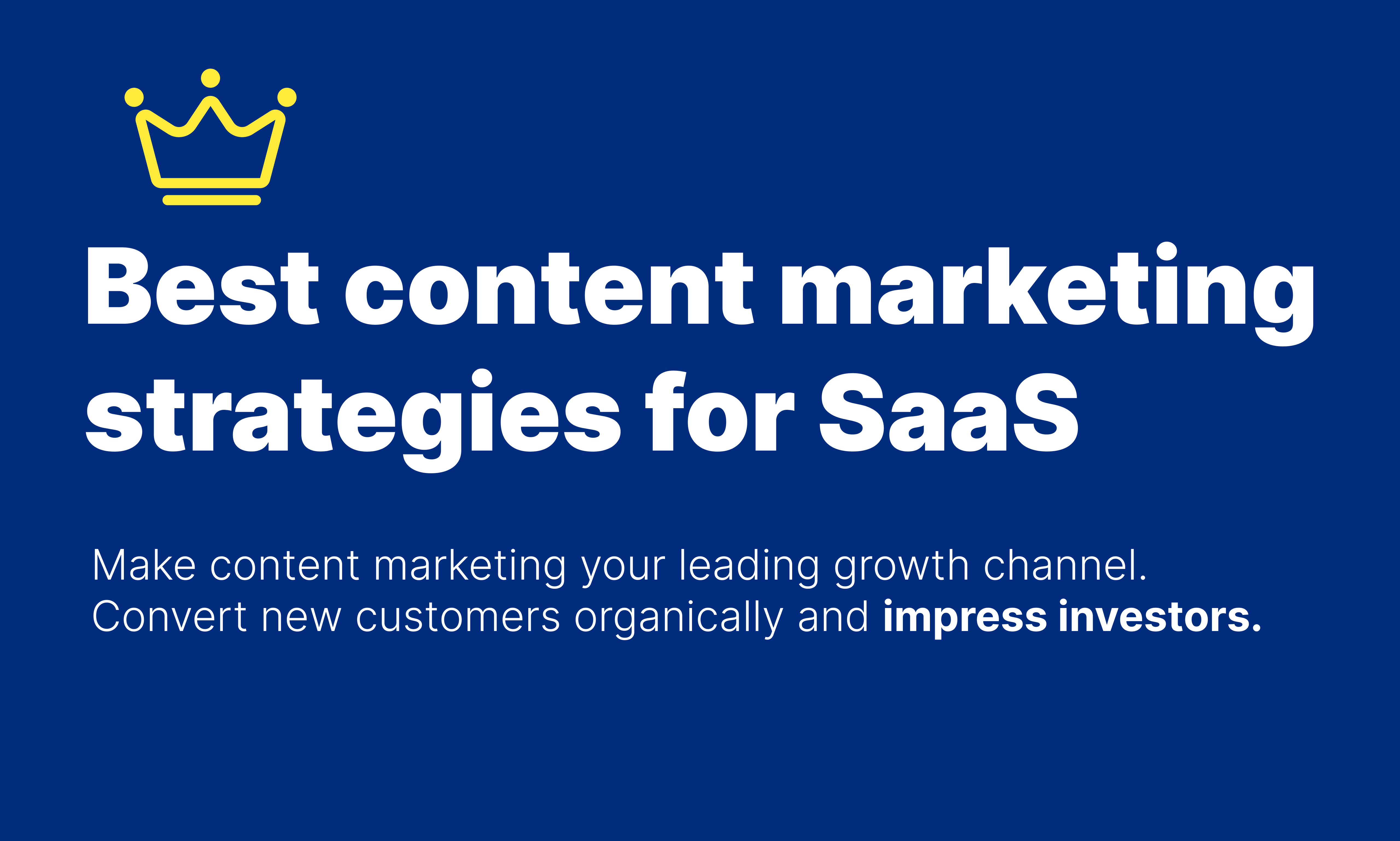
What is the point of content marketing?
It’s to gain and retain the attention of people. It’s a simple exchange between your business and a person willing to give their attention. In this exchange, you provide some kind of value to people through an engaging format. It can be educational, thought-provoking, entertaining, etc. And a person’s attention is the first step to converting this individual into a customer.
Here you’ll find the best content marketing strategies for SaaS, this includes blog content, social media posts, webinars, influencer marketing, newsletters, and more to gain and retain the attention of prospects across your funnel.
Content marketing resulted in a lead generation growth of up to 400% for SaaS businesses.
Best SEO Content Marketing Strategies for SaaS
Search engines are an essential tool for business decision-makers to make decisions on the software they purchase. But keep in mind that people usually just look at the first few results. So you need to fight as hard as you can to get a spot on the podium. Maybe at some point, SEO content was a passive thing with moderate results. But not anymore. You need to keep up with the constant changes in the algorithm and follow the best content marketing strategies for SaaS if you want to compete. These are some that you need to do.
1. Post high-quality, value-driven content in your blog consistently
Content is king, and high-quality, value-driven content reigns supreme in the realm of SEO. For SaaS businesses, producing in-depth, informative, and actionable content is essential. Whether it’s blog posts, guides, case studies, or whitepapers, your content should address user queries comprehensively, providing valuable insights and solutions.
According to 74% of B2B marketers, making valuable content is the top factor for content marketing success.
This is what a good process for creating great blog content looks like:
- Select the main keyword you want to target and look for it in Google.
- Research the first 5 results.
- Identify key headings, topics, keywords, and word count.
- Now write something that covers all of those things and more.
This essential strategy works because you’re taking the best points of content that Google already ranks highly and you’re improving on them. You can improve this content by giving a new perspective, adding more information, presenting more sources, etc.

We can do your content marketing
Uphill Content specializes in growing SaaS businesses, from early-stage to exit. See how we can help.
2. Create content and landing pages around long-tail keywords
Don’t go for the keywords with the most traffic. At least not until your site is highly authoritative. This will lead to you having a bunch of content that simply can’t compete with the big SEO players. Just target long-tail keywords that have more intent, less competition, and a higher likelihood of converting readers.
This strategy means that you need to do extensive keyword research and find search queries that are more specific and with little competition. If your SaaS website is just starting out, aim for a difficulty of 30% or less (based on SEMrush).
Utilize tools like SEMrush, Ahrefs, or Google Keyword Planner to find these keywords.
Here’s a good example. Instead of targeting “Recruiting Software”, you should target, “Recruiting Software for Small Business”. It has great volume and less than 30% difficulty.
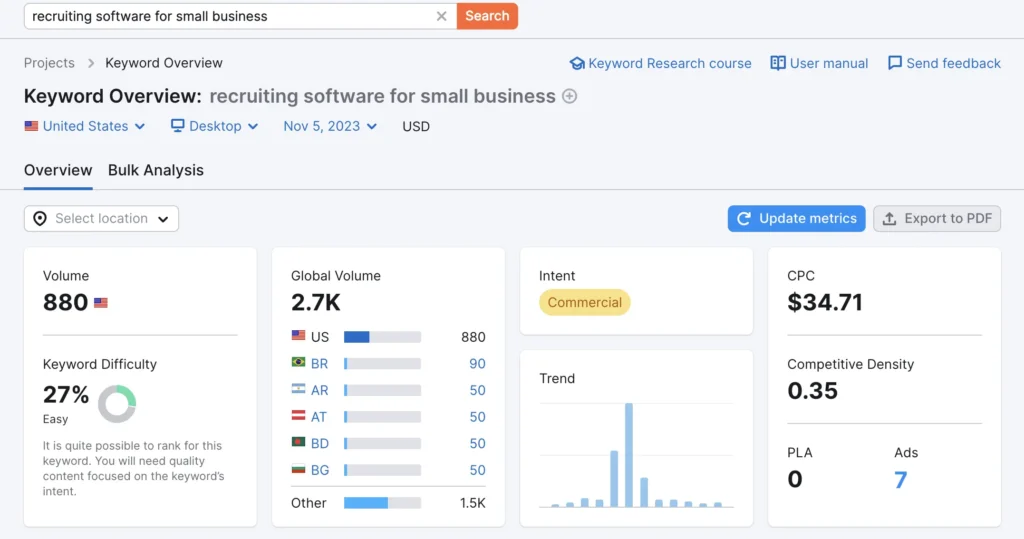
Once you have these keywords, make high-value content targeting them. But don’t limit yourself to blog posts. You can also create landing pages targeting these keywords. Build new landing pages around them or optimize existing ones to include them.
3. Optimize your site for mobile so you don’t lose visitors
With the majority of internet users accessing content via mobile devices, mobile SEO has become a necessity. You don’t want to be losing readers just because of poor responsiveness on your site. Google’s mobile-first indexing prioritizes mobile-friendly websites, so optimizing for mobile users can have a positive result in your rankings.
Responsive design, fast loading times, intuitive navigation, and clear CTAs (Call-to-Actions) are key elements of a user-friendly mobile experience.
User experience (UX) directly impacts SEO. A seamless, intuitive website layout reduces bounce rates and encourages users to explore multiple pages, indicating to search engines that your website provides valuable content. Additionally, mobile-friendliness enhances your chances of appearing in the coveted featured snippets, further amplifying your online visibility.
Use Google’s PageSpeed tool to analyze your site’s performance and follow the recommendations to improve mobile usability.
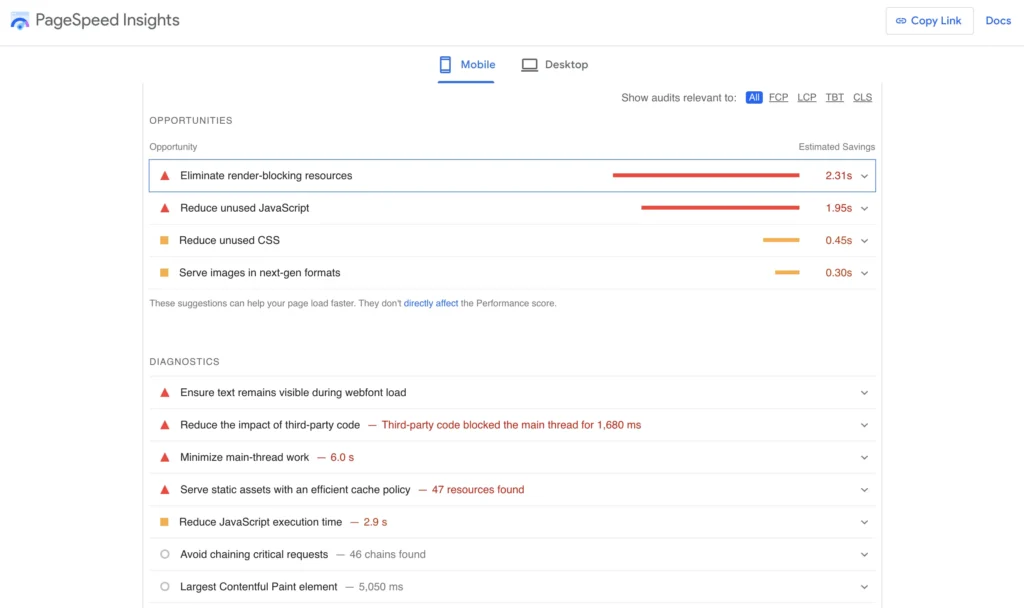
Ask your designers to keep this in mind when making new landing pages.
4. Build links through outreach, content, and HARO
Founders usually neglect backlinks. While marketers struggle to get them. But regardless, they remain a vital SEO factor for your rankings. So don’t underestimate them.
Backlinks have proven to be one of the biggest challenges, especially for newer sites. Without this authority, it’s unlikely that you get great rankings. Fortunately, there are plenty of relevant sites out there willing to link to your content. These are a few things you can try:
- Positively talk or recommend other software. Then reach out to them to let them know and kindly ask if they could share it or add a link somewhere in their content.
- Also, try that approach with industry experts. Ask for a quote or contribution and it’s very likely that they with share it with their audience.
- Ask relevant sites if you can write a guest post for them. Focus on quality and you’ll get a link back.
- Exchange links with other SaaS sites. However, don’t do this too much since Google doesn’t love exchanges. But if there is a good way both sites can mention each other organically, go for it.
- Create content that is so useful that others link to it. For example, reports with statistics.
- Keep an eye on HARO (Help A Reporter Out) for opportunities to contribute to another person’s article. Usually, these are the highest authority links you can find.
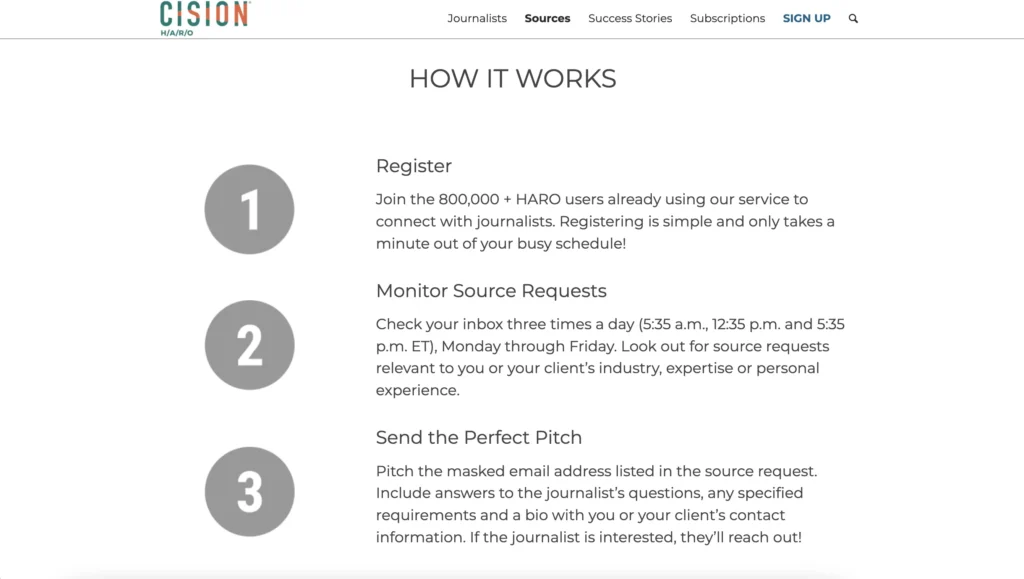
Also don’t forget to share and promote your content on social media. There is always the chance that someone likes your content so much that they link it. Doing so much outreach and building links can be exhaustive, but if you’re consistent, you can slowly but surely get great backlinks.
5. Optimize your technical SEO regularly
Technical SEO optimization ensures that search engine bots can crawl, index, and understand your website effectively. For SaaS businesses, technical SEO plays a vital role in improving website visibility. Focus on optimizing critical elements such as site speed, URL structure, meta tags, header tags, and schema markup.
Invest in HTTPS encryption, providing a secure browsing experience for users and earning your website a slight ranking boost. Conduct regular website audits to identify and fix issues like broken links, duplicate content, or crawl errors. Utilize tools like Google Search Console and SEO crawlers to monitor your website’s health and address technical glitches promptly.

Get a free SEO audit
Enter your business email below to get a free SEO audit with actionable insights to improve your site.
6. Leverage Google My Business
For SaaS businesses catering to specific regions or countries, local SEO optimization is a great idea. Plus, it makes your brand look more professional. It also makes it easy for prospects to find your information and reviews about your product. Claim your Google My Business listing and ensure accurate business information, including your address, phone number, and operating hours. Encourage satisfied customers to leave positive reviews, enhancing your local reputation.
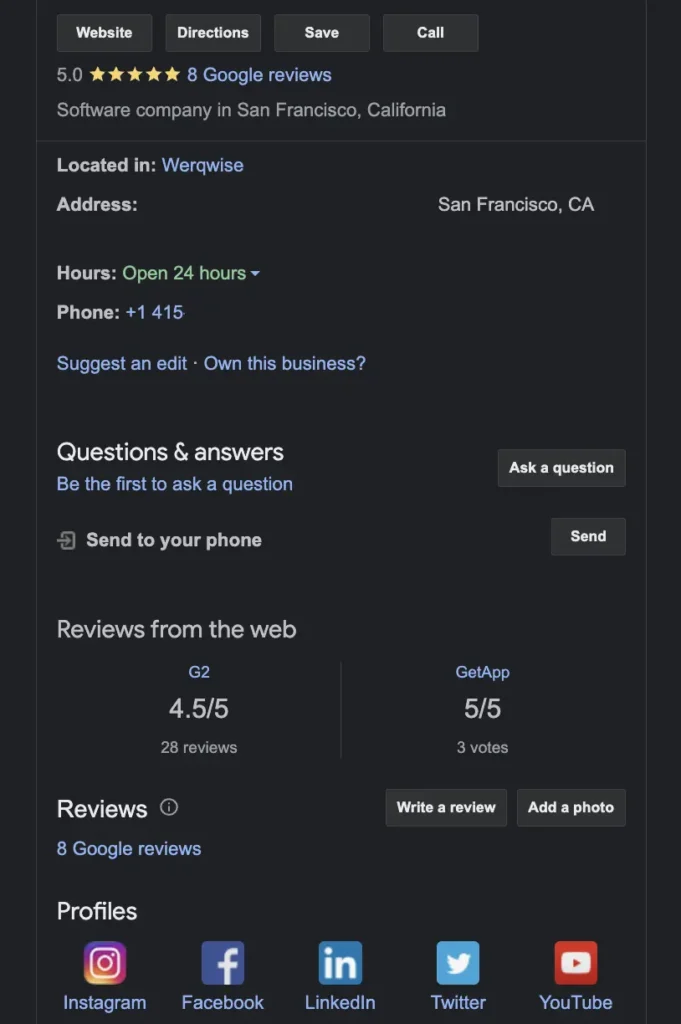
Localized content, tailored to regional preferences and trends, resonates more effectively with local audiences. Include location-specific keywords in your content, meta descriptions, and headers to optimize for local search queries. Engage with local communities, participate in local events, and collaborate with regional influencers to strengthen your local SEO presence.
7. Keep up with Google’s algorithm changes
Google frequently updates its algorithms to enhance user experience and provide the most relevant and authoritative content to its users. For example, recent changes have made page speed, responsiveness design, and overall user experience have become a more important ranking factor.
These changes impact search engine rankings, making it crucial for SaaS businesses to adapt their content strategies accordingly. Falling behind in understanding these updates can lead to a significant drop in organic traffic, hindering your SaaS company’s online presence and potential customer reach.
This is the page where you can stay up to date on the most recent updated: Google algorithm changes.
Always keep learning the best SEO practices and review Google’s algorithm changes. This way you can optimize your strategies, ensuring that your content aligns with the search engine’s criteria, ultimately leading to higher visibility, increased traffic, and enhanced user engagement.
Best Social Media Content Marketing Strategies for SaaS
Social media is the most common weak point in SaaS companies’ content marketing strategies. And the problem can always come down to 2 things. Either the content is not good or the company has no consistency. Social media, as well as all other content channels, is a long-term game. A few posts won’t do anything for you. You need to post every day, sometimes more than one post per day. You also need to keep your content varied and fresh.
Don’t be those SaaS companies that choose 3 content pillars and don’t vary that formula for years. Instead, follow the social media strategies for SaaS below.
1. Utilize your personal brand
B2B influencers are on the rise. More and more, you can see founders sharing their journey building and growing their startup. And it works.
Leveraging your personal brand is a powerful strategy in SaaS content marketing as it humanizes your company, establishes trust, and fosters genuine connections with your audience.
People connect with people, and by putting a face and personality to your brand, you create a sense of authenticity that resonates with your audience. Your personal brand can showcase your expertise, experience, and passion, positioning you as a thought leader in your industry. When your audience associates your personal brand with expertise and reliability, they are more likely to engage with your content, trust your recommendations, and consider your SaaS offerings.
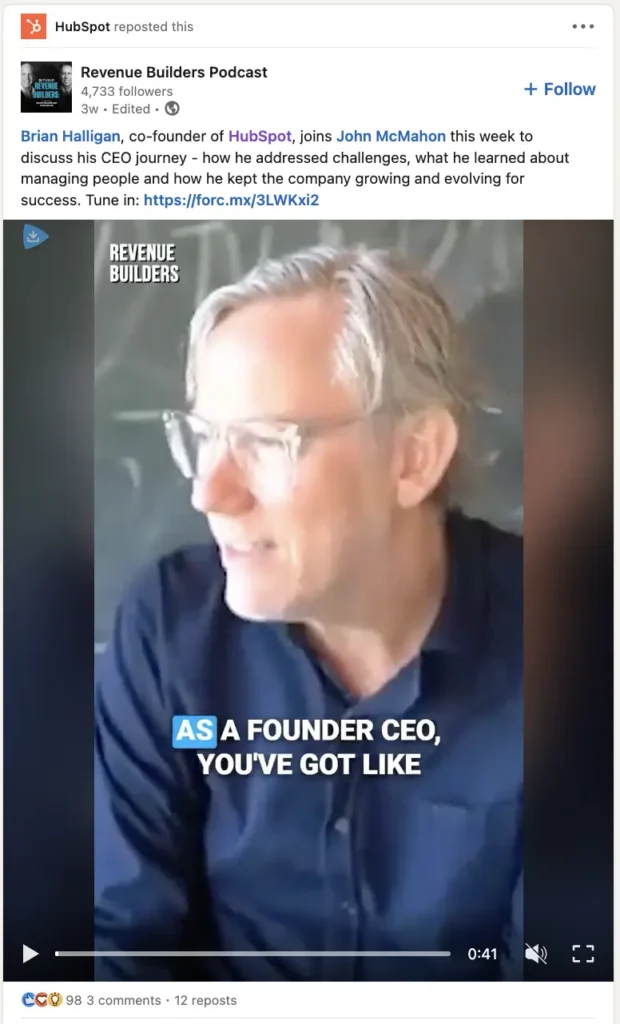
Treat your LinkedIn page or X accounts as your business accounts. Put consistent effort into posting regularly, varying your formats, and engaging with other posts. Establish yourself as a thought leader in your industry and share your journey openly.
2. Research your audience for content inspiration
Social media is inundated with content. And one great way to stand out is to go the extra mile when researching your audience. Many times, founders and marketers think of content they think is okay and go with it. But this is an issue because that doesn’t mean that your audience will connect with your content.
Conduct thorough audience research to decipher the demographics, preferences, challenges, and aspirations of your target audience. This should be the first step before putting any more content together.
Tailor your content to resonate with each segment, addressing their specific pain points and interests. Plus, utilize social media analytics tools to gain insights into user behavior, engagement patterns, and content preferences.
With this inbound content marketing strategy for SaaS, your content can connect with exactly the people you want.
3. Try all content formats
Visual content is king in the realm of social media. Leverage the power of visually appealing graphics, videos, infographics, and carousel posts to capture your audience’s attention. SaaS products, often intricate in functionality, benefit from visual storytelling that simplifies complex concepts. Create visually engaging explainer videos, product demos, and tutorials to showcase your software’s features and benefits.
Interactive content formats, such as polls, quizzes, and live Q&A sessions, are also great tools for you. Interactive content not only boosts engagement but also provides valuable insights into customer preferences and opinions.
Don’t just do the content that your competition is doing. Do better than them. A great example of this is the post below:

Apollo lets a person “take over” their account in an effort to co-market with another company, promote something, and more. This strategy is common in B2C companies, but it also worked in this instance. In that same way, think of different formats that can make your audience more connected with your brand.
40% of B2B buyers engage with 3 pieces of content on average before contacting sales.
4. Establish thought leadership through educational content
In the B2B world, expertise is a deal-winner or a deal-breaker. It is the way you establish trust in your solution. By offering valuable educational resources, you not only enhance brand credibility but also nurture a community of informed users.
Social media platforms serve as ideal spaces for SaaS businesses to establish thought leadership and share industry expertise. Create insightful thought leadership content, including:
- Articles
- Webinars
- Newsletters
- Reports
- Guides
- Whitepapers
In this content, address pertinent industry trends, challenges, and innovations. Thought leadership content positions your brand as an authority within your niche, attracting professionals seeking valuable insights and knowledge.
You’ll see most SaaS platforms using this social media content marketing strategy, and you should get on board too.

Stand out on any social media platform
Boring and one-dimensional social media strategies won’t make you stand out. But we can.
5. Utilize user-generated content
User-generated content (UGC) is a potent social media content marketing strategy that leverages your existing customers as brand advocates. This just basically means content created by your customers on social media. UGC adds authenticity to your brand, showcasing real-life use cases and customer satisfaction.
Encourage satisfied customers to share their success stories, testimonials, and experiences with your SaaS product. The best way to get this content is by simply asking. If your customers are happy with your solution, they won’t mind giving you a shoutout.
Run UGC campaigns, contests, or challenges that encourage users to create content related to your SaaS product. Reward participants with incentives, discounts, or exclusive access to premium features. UGC not only amplifies your brand’s reach but also builds a sense of community around your product.
6. Run ad campaigns on social platforms
Social media advertising platforms, including Facebook Ads, Instagram Ads, LinkedIn Ads, and Twitter Ads, offer highly targeted advertising solutions for SaaS businesses. Leverage the robust targeting options these platforms provide to reach specific audience segments based on demographics, interests, job roles, and online behavior.
Craft compelling ad creatives that resonate with your target audience, addressing their pain points and offering solutions. You can also promote your top-performing content, like the example below:
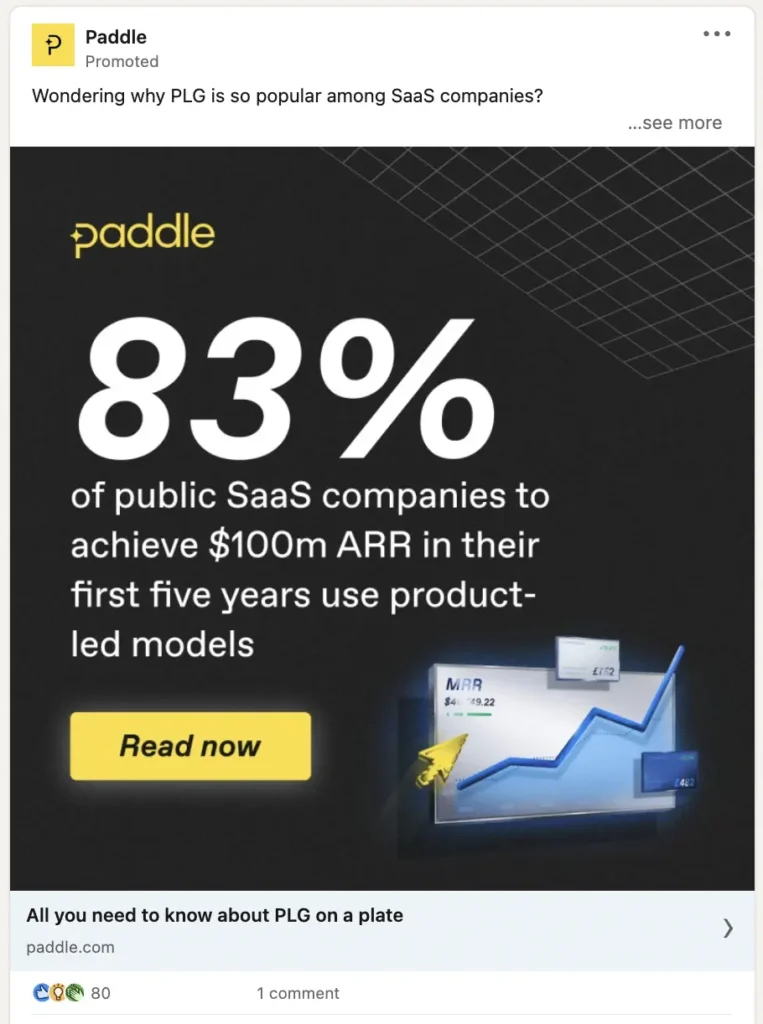
But don’t leave it there. Implement retargeting campaigns to re-engage users who have interacted with your website or social media profiles. Retargeting ads remind potential customers of your SaaS offering, nurturing them through the conversion funnel. A/B testing different ad formats, visuals, and ad copies allow you to optimize your marketing campaigns for maximum effectiveness.
Fortunately, some platforms offer businesses credits to jumpstart their ad campaigns.
7. Engage in all communities you can
You’ll know that your SaaS content marketing strategy is successful when people when there are people who don’t remember where they first discovered your brand. The reason is that you need to be everywhere at all times. People engage in different platforms and groups, so it’s very important for you to be involved in the online discussions that matter the most.
Create an account on:
- Slack
- Quora
Plus, any other platform with topic-based groups. Identify key groups on these platforms and go through recent posts regularly. Then, engage. Respond to other posts, create your own ones, and generally provide value to people without being salesly. People respond better to posts that are genuine.
So don’t try inserting your brand in all your contributions. Provide your expertise and be honest about your connection with your brand. This will give your SaaS a compounding effect that in the long run will drive a lot of brand awareness, and eventually conversions.
8. Collaborate with other content creators
Influencer marketing has emerged as a powerful social media strategy for SaaS businesses. Collaborate with influencers and industry experts relevant to your niche. Influencers lend authenticity to your brand, leveraging their credibility and followers’ trust to promote your SaaS product.
Identify influencers whose audience aligns with your target demographic and engage them for sponsored posts, reviews, or endorsements.
Influencer-generated content often feels more genuine and relatable, resonating well with the audience. Influencers can create engaging content formats such as unboxing videos, tutorials, or product reviews, showcasing your SaaS product in an authentic manner.
Influencer partnerships expand your brand’s reach, driving traffic, engagement, and potential conversions. Additionally, influencers can participate in live events, webinars, or AMA (Ask Me Anything) sessions, further enhancing audience interaction and brand affinity.
Best Email Content Marketing Strategies for SaaS
Just as with other content marketing channels, having a one-dimensional strategy is not good enough for SaaS companies. There are more email marketing strategies that you can use to make your email campaigns effective.
1. Segment your contacts and send personalized campaigns
One-size-fits-all emails no longer cut it in the competitive landscape of SaaS. Segmentation and personalization are pillars of a successful email marketing strategy for SaaS businesses. By segmenting the email list based on various criteria such as user behavior, demographics, or subscription plans, you can tailor your content to specific audience segments.
Personalization goes beyond merely addressing recipients by their first names. It involves crafting emails that resonate with the recipient’s interests, preferences, and past interactions with the brand. SaaS businesses can utilize data from user activities, such as feature usage or content engagement, to send targeted emails offering relevant tips, product updates, or exclusive offers.
2. Send onboarding and product education campaigns
After-purchase content is often neglected by SaaS platforms. But content is not only for attracting customers, it also helps retain them and even upsell. Use email to give new customers a welcoming experience with educational resources to use your product to its maximum potential.
This will excite customers about the possibilities of using your platform and they won’t feel awkward using it in the first months. Plus, send more campaigns reinforcing this idea and talking about product updates and tips to get more benefits from your SaaS.
In addition, promote your content from other channels in your email campaigns. This way customers will remain engaged and won’t abandon ship for not taking full advantage of your product.
3. Build automated drip campaigns
Drip campaigns involve sending a series of pre-scheduled emails to leads or customers over a specific period, guiding them through the buyer’s journey. For SaaS businesses, drip campaigns can be tailored to various scenarios, such as:
- Free trial users
- Inactive users
- Subscribers expressing interest in specific features
- Subscribers to your blog and newsletter
- People who filled out a form
Drip campaigns can be instrumental in encouraging people to become customers or to upgrade their subscription plans. By sending targeted emails highlighting the benefits of premium features, exclusive offers, or limited-time discounts, you can entice users to explore higher-tier plans. These emails can include success stories, case studies, or testimonials, showcasing the value premium plans bring to the table.
4. Create interactive emails to encourage actions
You need to get creative with your email.
Interactive emails, such as quizzes, polls, or infographics, engage recipients actively, encouraging them to participate and interact with the content. For SaaS companies, interactive content can be leveraged to:
- Gather feedback for product improvements
- Gauge user preferences
- Upsell
- Improve connection with your brand
- Get user reviews
Gamification is another effective strategy in email marketing for SaaS. By incorporating gamified elements, such as challenges, rewards, or competitions, SaaS companies can create a sense of excitement and encourage user participation. Gamified emails can be used to promote new features, celebrate milestones, or foster a sense of community among users. Gamification not only boosts engagement but also strengthens brand loyalty, making users feel more connected to the SaaS product.
Other Content Marketing Strategies for SaaS
Let’s look at other popular SaaS content marketing strategies and how to do them correctly.
1. Start a podcast or webinar series
Podcasts and webinars have gained immense popularity as on-the-go learning resources. Hosting your own podcast or webinar series enables you to share valuable insights, interview industry experts, and discuss relevant topics with your audience. Webinars and podcasts allow users to consume information while multitasking, making it an accessible and engaging format.
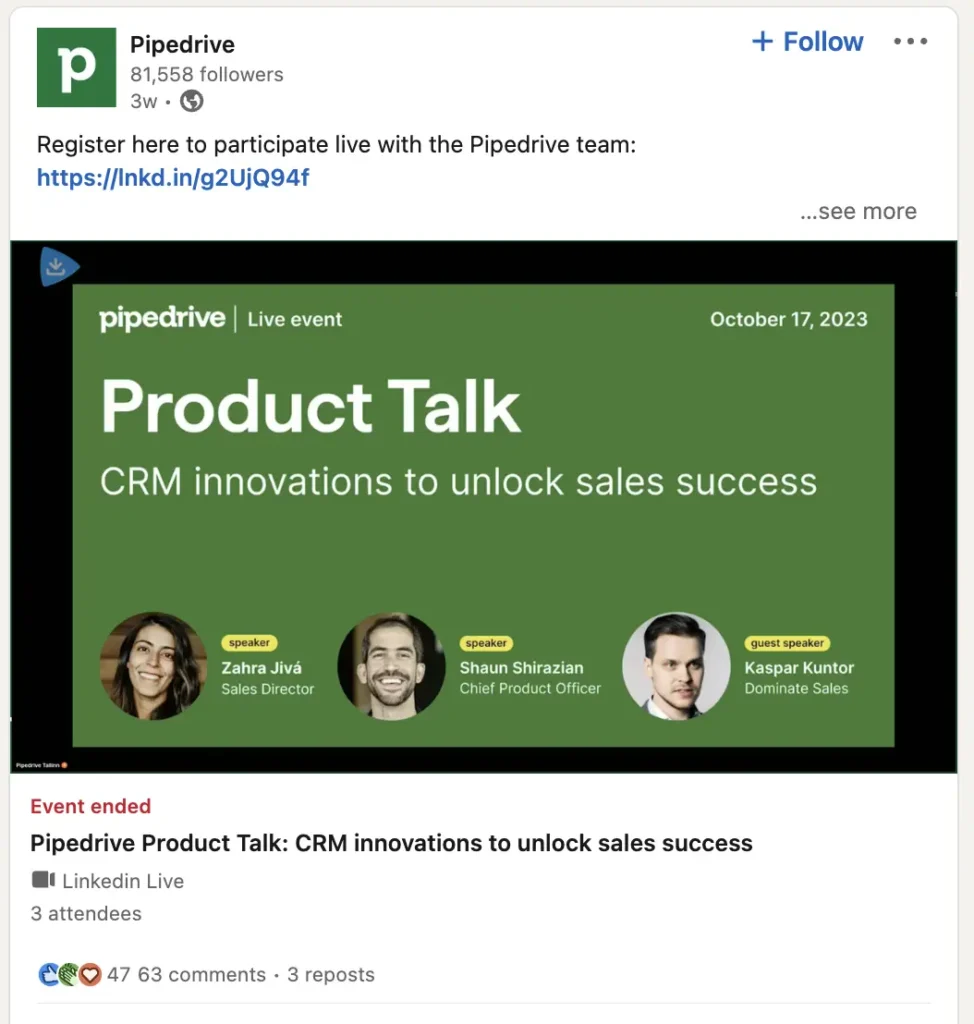
Invite thought leaders, customers, or employees to participate, offering diverse perspectives and enriching the content experience. This also gives you more content variety for your other channels. So, promote your podcasts and webinars on social media and other platforms to maximize reach and audience engagement.
51% of B2B SaaS marketers say webinars were their most successful type of video content.
2. Write case studies to show your potential
Case studies and success stories provide tangible evidence of your SaaS product’s effectiveness. Showcase how your solution addressed specific challenges faced by your customers, detailing the implementation process, strategies employed, and outcomes achieved. Include quantifiable results and testimonials from satisfied clients to add credibility to your narratives. Case studies not only highlight your product’s capabilities but also inspire confidence in potential customers, showcasing real-world applications and demonstrating your commitment to customer success. If possible, also try getting video case studies and testimonials, since video is a more engaging format than just text. Start simply by sending a list of questions to agreeing top customers. Then use those questions to craft your case studies. Use these case studies as much as possible, since they work on all stages of the sales funnel, especially in the later stages.
Nearly 40% of SaaS companies say that case studies are very effective at boosting sales (this was the most effective marketing tactic according to the report).
3. Offer some features for free
Many SaaS companies offer some features for free on their website. For example, Ahrefs has a variety of free SEO tools available on their website. They don’t even ask you to sign up. But these tools are so useful that they generate a lot of traffic. This is one of the most powerful content marketing strategies for SaaS for this reason but also because you give people a taste for your product, just like a free trial but with less commitment. Through these free tools, you can also demonstrate the value of your other features and motivate people to become a customer. So take a look at your features and choose one or a few that can draw a lot of attention without giving away your product.
4. Create shareable infographics and reports
SaaS companies and businesses of all kinds also have their own content marketing strategies, and they need to post content regularly. So if you provide them with infographics and reports with interesting information, they will be open to sharing it and using it in their content. The benefit of this is that you’re able to reach new audiences as well as establish your brand as a source of highly valuable data. This is why SaaS products such as HubSpot are regularly posting statistics and reports. Those pieces of content get shared and linked by thousands of businesses, increasing their awareness, thought leadership, and lead generation. Post this content on your blog and social media.
Content marketing produces 3X better leads than traditional marketing.
5. Build a forum and knowledge bases to educate on your product
You should interact in online communities, but you should also try building your own. User forums and knowledge bases serve dual purposes: they provide valuable resources to your customers while fostering a supportive community around your product. Establish an online forum or community platform where users can ask questions, share insights, and collaborate. Actively participate in these forums, addressing queries and providing expert advice. Additionally, create a comprehensive knowledge base with tutorials, FAQs, troubleshooting guides, and best practices. A well-maintained knowledge base not only assists users in utilizing your product effectively but also reduces the strain on your customer support team, enhancing overall customer satisfaction. You can start with a Facebook group, Discord server, etc. But you can also build it into your website.
6. Record visual explainers and interactive demos
Visual explainers and interactive demos provide a firsthand look at your SaaS product’s functionality and ease of use. Create visually appealing explainer videos that walk users through key features, benefits, and practical applications. Interactive demos allow users to explore your software in a controlled environment, simulating real-world usage. These immersive experiences offer potential customers insights into your product’s user interface, functionalities, and overall user experience. Visual content creates a lasting impression, making it easier for users to understand the value proposition of your SaaS solution.
7. Implement gamification
Gamification involves integrating game-like elements, such as points, badges, challenges, and rewards, into non-game contexts to enhance user engagement. Implement gamification elements within your SaaS platform, encouraging users to complete tasks, achieve milestones, or participate in challenges. Gamified experiences tap into users’ intrinsic motivations, fostering a sense of achievement and competition. Obviously, this content marketing strategy for SaaS is not for everyone, but if it’s possible for your specific product, then you should give it a try.
8. Build a good brand reputation
Incorporate social responsibility and sustainability initiatives into your content marketing strategy to showcase your brand’s commitment to ethical practices and community well-being. Highlight your environmentally friendly practices, charitable initiatives, or partnerships with nonprofit organizations. Share stories of how your company is making a positive impact, whether through charitable donations, eco-friendly initiatives, or community outreach programs. Socially responsible content not only enhances your brand’s image but also resonates with socially conscious consumers, fostering a positive emotional connection with your brand. But only do this if you’re actually doing something positive.
Cost of Content Marketing: In-House vs. Agency
With so many content marketing strategies for SaaS, you need a team of marketers to be able to do all of these campaigns correctly. Each one requires a hands-on approach with constant tracking and optimization. Just half-assing some of these strategies won’t give you great results, especially considering that content marketing depends on consistency.
So now the question is, what is more affordable, an in-house marketing team or an agency?
In-house marketing team cost
In-house teams have the advantage of direct control, with the ability to align content strategies closely with the company’s vision and goals. However, building and maintaining an in-house team requires significant investment in recruitment, training, and ongoing management. Based on Indeed salary statistics this is what a small 3-person team could cost you.
- Marketing Director: $54,768 – $172,332 per year
- Digital Marketing Coordinator: $35,638 – $73,050 per year
- Graphic Designer: $34,517 – $97,511 per year
With those numbers in mind, your small Marketing team could cost you anywhere from $124,923 to $342,893 per year
SaaS marketing agency cost
In contrast, based on our SaaS agency’s numbers, you can get a full-service experience that includes SEO, content writing, social media management, strategy, PPC, email marketing, landing page building, and more can cost you from $2,000 per month. This would be $30,000 per year, less than the lower range of a single marketing member.
But if you don’t want full-service marketing, then you can purchase individual services on their own for a lower price, like content writing or social media marketing management.
Partnering with a content marketing agency offers several advantages. Agencies bring a wealth of experience and expertise to the table, often working with a diverse range of clients across different industries. Agencies operate with a dedicated team of professionals, including writers, designers, and SEO experts, eliminating the need for extensive in-house staffing. Plus, agencies typically offer scalable solutions, allowing SaaS companies to adjust their content marketing strategies based on their budget and goals.
57% of the most successful B2B SaaS companies outsource their content marketing strategy.
Why Content Marketing Is Different for SaaS?
SaaS businesses operate in a distinctive way, where the nature of their services necessitates a specialized approach to content marketing. Unlike traditional products or services, SaaS offerings demand a deeper understanding of the industry, more intricate audience research, and a nuanced content strategy. Best practices for all channels are constantly updating, so it’s difficult to keep up. These are the main differences between content marketing strategies for SaaS and other business models:
- Content needs to be targeted at businesses and professionals
- Content needs to demonstrate expertise
- Content is more technical
- Educational content is more important than entertaining
- LinkedIn is the most important social media platform (generally)
- Your content should target all stages of the funnel
With this in mind, you should partner with a marketing agency or professional that specializes in SaaS.
Grow Your SaaS With the Best Content Marketing Strategies Today
Content marketing for a SaaS is challenging, but 100% worth it if done correctly. You need to stay consistent for a long period of time and results might not be obvious at first. It takes time for content to reach its potential, but once you get a hang of it, the content will work for itself, attracting, converting, and retaining customers effortlessly.
The best time to start is today. So look at the SaaS marketing strategies from this article and start creating! If you’d like to implement these strategies in easy mode, then send us a message. We can take care of all your SaaS marketing needs without burning through your budget. Let’s connect!
